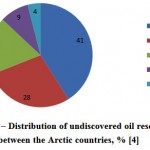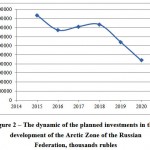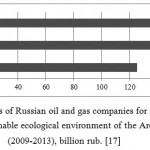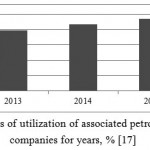How to Cite | Publication History | PlumX Article Matrix
Sustainable Development of the Arctic Zone of the Russian Federation: Ecological Aspect
Alina Alexandrovna Ilinova and Diana Mihaylovna Dmitrieva
PhD in Economics, Assistant Professor, Organization and Management Department, Saint-Petersburg Mining University.
DOI : http://dx.doi.org/10.13005/bbra/2370
ABSTRACT: The objective of this paper is to define the main approaches to the sustainable development of the Arctic zone of the Russian Federation, and to identify main problems and opportunities in ecological sphere. Nowadays one of the most priority directions of the Russian economic development is an effective development of the Arctic zone. The Arctic zone of the Russian Federation is a part of the Arctic, which is under the jurisdiction of the Russia Federation. Main types of the Arctic zone mineral resources are presented. The legal and regulatory framework of the Arctic regions’ development are examined. Special attention is paid to ecological aspect of the Arctic zone’s development.
KEYWORDS: Arctic zone; sustainable development; ecological aspect; mineral resources; legal regulation
Download this article as:| Copy the following to cite this article: Ilinova A. A, Dmitrieva D. M. Sustainable Development of the Arctic Zone of the Russian Federation: Ecological Aspect. Biosci Biotech Res Asia 2016;13(4). |
| Copy the following to cite this URL: Ilinova A. A, Dmitrieva D. M. Sustainable Development of the Arctic Zone of the Russian Federation: Ecological Aspect. Biosci Biotech Res Asia 2016;13(4). Available from: https://www.biotech-asia.org/?p=16982 |
Introduction
The strategic value of the Arctic zone of the Russian Federation means, first, that there is a unique location of the mineral resources on this territory. In this region, there are reserves and predicted resources of rare metals and other minerals. In the north part of the Arctic zone, there are the main resources of copper nickel ore, platinum and rare earth metals, tantalum, titan, iron, niobium, polymetals, phosphorus, fluorite, chrome, manganese, diamonds and gold. In addition, the most important today is oil and gas fields’ development. Arctic oil and gas reserves count about 250 million barrels according to the latest research and it exceeds the annual production of the world’s leader in oil sphere – Saudi Arabia – in 22 times. The Arctic shelf in the future can become the main source of hydrocarbons for both Russia and the world market in the whole [1,2].
That is why one of the most important aspect of the Arctic zone’s sustainable development is an environmental issue. The mining activity affects our environment,so, as a result, water becomes dirty, the atmosphere – polluted because of different emissions, formations of technogenic dumps, a radical reorganization of the relief and others. Besides, the composition of the hydrocarbon deposits also has both hydrocarbons and mutagenic and more toxic oil components such as resins, asphaltenes and heavy metals (vanadium, uranium, nickel). Therefore, the importance of ecological aspect in planning for sustainable development of the Arctic region cannot be overestimated.
Methodology and Methods
Mineral reserves of the Arctic territories
In table 1 there is a list of the main types of the Arctic zone’s mineral resources [3].
Table 1: Main types of the Arctic zone mineral resources
| Groups | Types of resources | Mineral resources |
| Fuel and energy resources | Solid fuel and energy raw materials | Coal, uranium, combustible shales, methane |
| Liquid and gaseous energy resources | Raw energy oil, flammable gases, natural bitumen | |
| Mineral resources:
Metallic minerals
|
Ferrous metals | Iron manganese titanium vanadium chromium |
| Rare metals | Bismuth, aluminum, copper, tin, nickel, cobalt, antimony, selenium, zinc, tellurium, tungsten, mercury, molybdenum | |
| Precious metals | Silver, gold, platinum, palladium | |
| Rare metals | Lithium, niobium, tantalum, zirconium, beryllium, the lanthanides | |
| Non-metallic minerals | Mining and chemical raw materials | Phosphates, mineral salts, apatite |
| Mining and technical raw materials | Barite, graphite, arsenic, mica, abrasives | |
| Crystal and semiprecious stone material | Gemstones, diamonds | |
| Organic raw | Amber |
As it is seen in the table, the list of the mineral resources of the Russian Arctic zone is wide. As it was noted above, the special attention today is paid to oil and gas fields’ development. In figure 1,there are the dates about the distribution of undiscovered hydrocarbon reserves among the Arctic countries.
 |
Figure 1: Distribution of undiscovered oil reserves between the Arctic countries, %. |
According to the estimates, the total cost of mineral raw materials in the subsoils of the Arctic regions of Russia exceeds 30 trillion dollars. However, the total cost of explored reserves is only 1,5 – 2 trillion dollars, that shows a low level of deposits’ exploration [4].
The legal regulation of the Arctic regions’ development
The development of the Arctic region at the state level is carried out by formulating and taking different normative legal documents to the actions. The main document about the issues of the Arctic’s development is The Strategy of developing the Arctic zone of the Russian Federation and national security system for the period till 2020[5] and a list of other documents.
Analyzing the normative and legal framework foundation about the issues of the Arctic regions’ development it is possible to make a conclusion that most likely it has a theoretical character than practical. So, for example, according to The Strategy of region’s development till 2020 as in many other documents there are the main aims, tasks, methods and directions of the strategy’s realization in a form of thesis, however, there are not certain specific activities and measures which could lead to the development of the strategically important zone. In addition, the weakness is a monitoring providing and a control of set goals realization, and appointing people who will be responsible for achieving their results.
For example, according to the State program of the Russian Federation «Socio and economic development of the Arctic Zone in the Russian Federation for the period till 2020» (is approved by the government’s resolution since 21.04.2014 № 366) the total amount of financing in 2015-2020 will be 221 822 million rubles. Figure 2shows the dynamic of the planned financing in the structure of socio-economic development of the Arctic Zone. The largest volume was invested in 2015 and amounted about 50 billion rubles; the dynamic of investments since 2018 until 2020 is decreasing. The expected declared total income of the Russian Federation’s budget due to the realization of the strategy will be about 3,2-4,0 trillion rubles [6].
 |
Figure 2: The dynamic of the planned investments in the development of the Arctic Zone of the Russian Federation, thousands rubles. |
Such significant funding for the Arctic region’s development lead to the need of a thorough analysis and developing specific and more effective activities in modern conditions, the linking of main policy documents between in time and space and also the development and implementation of the serious monitoring and control system, the tracking of set goals, objectives and indicators. Just in this case there is an opportunity to achieve the effect from the investments of financial resources in the region’s development.
The ecological aspect of the Arctic zone’s development
The competent environmental policy is the strategic basis for the effective use of mineral resources in the Arctic territories, and for the strengthening of national security at the state level and of the socio – economic development of the region.
As it is noted in «The Strategy of the Arctic region’s development till 2020» the natural systems of the Arctic zone are unstable, that becomes another separate problem, which requires attention [5].
The experts in the field of environmental audit and management mark about 100 so-called «impact areas» of the Arctic zone of the Russian Federation which are connected with the industrial production. In many areas, the ecological situation associates with such global consequences as the transformation of the geochemical background, the increased concentration of harmful substances in the environment, the observed increase in the population morbidity. In the whole, according to the experts’ opinion the territories of the Russian Arctic where there is a critical level of pollution amount at least 15% of the region’s area. «The leaders» in such rating are the Murmansk region (10% of specific emissions of pollutants), Norilsk region and Western Siberia (over 30%), Arkhangelsk oblast [7].
So, the range of environmental problems inherent to this area can be grouped as:
The complex environmental pollution, particularly chemical, radioactive, oil pollution and,as a result, the decrease of the quality in surface and ground waters of the Arctic coastal areas.
Degradation of soils.
Biodiversity change in the negative direction and the decline of bioresources.
The deterioration of the living environment for the population and,therefore, the quality of life in general.
The climate change (the greenhouse effect); this problem is particularly topical at the international level [8].
In this regard in «impact areas» of the Arctic zone of the Russian Federation, it is required to adopt some effective measures for efficient implementation of an innovative environmental activity.
In the international practice, there is a number of developed documents and agreements of monitoring and elimination of negative environmental consequences on the Arctic territories. An important role in international environmental cooperation’s formation in the Arctic plays such environmental organizations and structures as International Independent University of Environmental and Political Sciences, International Arctic Scientific Committee, Arctic Monitoring and Assessment Programme, World Meteorological Organization, Greenpeace, World Wildlife Fund and others. The most influential are such international organizations as the Arctic Council, Convention for the Protection of the Marine Environment of the North-East Atlantic (OSPAR)and Helsinki Commission (HELCOM). Russia is a permanent member of the Arctic Council [9-15].
The Russian Federation has a number of documents, projects and agreements (most of them are international) about this issue. However, as in the overall strategy of development of the Arctic region in Russia, the definition of specific practical activities in this way is not provided. You can be convinced in it having considered the Russian legislation in comparison with the legal framework of foreign countries (Table 2).
Table 2: Features of environmental law of the Arctic issues in different countries
| Arctic
countries |
Regulatory documents and laws | Features of legislation |
| USA | Outer Continental Shelf Lands Act | There are the obligations for companies about monitoring organization at all stages of mining and geological activity; oriented to the provisions of the Arctic Council |
| Denmark | Exploration Drilling Guidelines | There is a detailed description of certain actions that companies are obliged to carry out before and during exploration activity; oriented to the provisions of the Arctic Council |
| Norway | Guidelines for offshore environmental monitoring | There are specific recommendations for companies to conduct environmental and ecological audit with the exact indicators and standards |
| Russia | The Federal Law on Environmental Protection; the Federal Law on the Continental Shelf of the Russian Federation; License terms for the subsoil usage | There are ecological obligationsonly within the production control, requirements for monitoring and developing appropriate programs |
The disadvantages of the Russian legal framework system are generalization of indicators and standards and the lack of connection between legal documents and real state of the individual territories. Solving this inconsistency requires the development of regional standards, taking into account directions of technological impact, background concentrations of pollutants and others.
In the normative legal acts regulating the environmental sector there are also the issues of financing. So, for example, for cleaning the Arctic territories of Russia from industrial wastes in 2014-2025 about 22,9billion rubles will be allocated, and 20,9 billion rubles of them are from the Federal budget [16].
From the conducted large-scale events, it is possible to emphasize «Spring-cleaning», which was done in 2012-2013 on the Arctic territories on the initiative of the authorities. As a result, about 250 tons of scrap metals were collected [16].
The costs of Russian oil and gas companies for the maintaining of the ecological situation in the Arctic zone of the Russian Federation are presented in figure 3.
 |
Figure 3: The costs of Russian oil and gas companies for maintaining a sustainable ecological environment of the Arctic (2009-2013), billion rub. |
Now a days a large portion of such costs is connected with coercive policies of the government with regard of the utilization of associated petroleum gas (Figure 4).
 |
Figure 4: The volumes of utilization of associated petroleum gas by Russian companies for years, % |
Also the drawback of the Russian legislation is undeveloped system of fines for ignoring environmental standards by companies. For example, in the USA significant monetary penalties are set. Here on average 1 barrel of spilled oil is about $ 8000 of penalties and other charges that is an effective incentive to prevent them. In the whole, the costs for ecological safety in the Arctic zone of American companies from 1990 to 2012 were about $ 268 billion doll that exceeds the total costs of Russian companies [17].
Results and Discussion
Therefore, the Arctic region of the Russian Federation is strategically important for the whole country because of its unique mineral raw material base and perspective ways of the logistics infrastructure. In the Arctic zone about 12-15 % the country’s GDP is created and almost a quarter of exports is provided.
Despite significant investments for the region’s development from the government, the Arctic zone of the Russian Federation has been developing quite slowly, including in the sphere of ecological and environmental development. The sustainable development of the region is hindered by such negative factors as:
– low efficiency of the state regulation of sustainable development of the Arctic territories;
– heavy climate conditions of the region;
– poor infrastructure of the Arctic zone;
– low efficiency and profitability of natural resource extraction due to the absence of integrated development of the territory and innovative development of the region;
– high energy intensity of natural resource extraction because of undeveloped energy system in the region;
– the absence of an integrated approach to environmental aspect of the Arctic zone’s development and some others.
To improve the ecological aspect of integrated and sustainable development of the Arctic the following events and actions can be offered.
First, it is necessary to improve the legal component. Despite the main different international cooperation agreements in the framework of environmental management, the powerful effective Russian regulatory legal base should become a good foundation for development of territories. Special attention should be paid to control and monitoring, especially in the area of allocation of financial resources.
Furthermore, the monitoring of ecological situation must be hold separately for each subregion so that to consider such specific features.
Assignment responsibility on mining companies for keeping ecological standards in the area of environmental management should be associated, on the one hand, with various benefits and tax incentives to stimulate the introduction of new technologies, and, on the other hand, with increasing of fines and the introduction of different sanctions for failure to comply with environmental obligations. The special role in this issue is assigned to up-to-date extraction technologies and oil and gas recovery technologies, providing energy effectiveness and ecology safety [18,19].
Having the open ecological policy by companies and attraction of residents of the Arctic territories for participating in the development and realization of environmental events can play an important role for creating a positive reputation of companies among local people. Creating and increasing the number of already existing environmental services also can have a positive influence on non-stop monitoring of the sub regions’ eco-condition, that will allow to respond to any deviations faster and more effective.
Conclusions
In the whole, at this stage the Russian Federation largely keeps up from the European countries and USA in the sphere of environmental issues, that is why close cooperation with international ecological organizations can have a positive effect both on the development of the national science and in this area, and on the improvement of new ecologically friendly technologies. Innovative development of the region in an ecological aspect will help to save ecosystems of the most important strategic region of the Russian Federation for the furthereffective and sustainable development of the country.
Acknowledgements
The paper is based on research carried out with the financial support of the grant of the Russian Science Foundation (Project No. 14-38- 00009, The program-targeted management of the Russian Arctic zone development). Peter the Great St. Petersburg Polytechnic University.
References
- Bortnikov, N. S. Strategic mineral resources of the Russian Arctic and problems of its extraction. Scientific and technical problems of the Arctic development: book of reports, 2014; 40 – 47.
- Pantyukhin, A. Arctic is a region of Russia. International affairs, 2016; URL: https://interaffairs.ru/news/show/15036
- Dodin, D. A., Kaminskiy, V.D., Zoloyev, K. K., Koroteyev, V. A. The strategy of development and studying of mineral raw material resources of the Russian Arctic and the Subarctic region in the conditions of transition to sustainable development. The Lithosphere, 2010; 6: 3-24
- Policy of Russia in the Arctic: how to avoid new Cold War. The Report of grantees of the International debating club “Valdai”, Moscow, September, 2014.
- «Strategy of developing the Arctic zone of the Russian Federation and national security system for the period till 2020». URL: https://minec.gov-murman.ru/upload/iblock/b36/strategy_azrf.pdf
- «Socio and economic development of the Arctic Zone in the Russian Federation for the period till 2020». URL: https://minec.gov-murman.ru/upload/iblock/b36/strategy_azrf.pdf
- Sokolov, Yu. I. Arctic: to the problem of cumulative ecological damage. The Arctic: ecology and economy, 2013; 2 (10): 18-27.
- Maximov, V. M., Tupysev, M. K., Kulpin, L. G. Some problems of ecological and industrial safety of natural and technogenic sea objects in case of development of the Arctic shelf. The Arctic: ecology and economy, 2014; 4 (16):60-67.
- Arctic Council. URL: http://www.arctic-council.org/index.php/ru/
- Arctic Monitoring and Assessment Programme. URL: http://www.amap.no/
- Convention for the Protection of the Marine Environment of the North-East Atlantic. URL: http://www.ospar.org/
- Helsinki Commission (HELCOM). URL: https://www.csce.gov/org/
- International Arctic Scientific Committee. URL: http://iasc.info/
- International Independent University of Environmental and Political Sciences. URL: http://www.mnepu.ru/
- International practice of environmental monitoring on the Arctic shelf. URL: http://pro-arctic.ru/.
- Environmental problems and cleaning of the Arctic. URL: http://www.arctic-info.ru/Ecology
- Costs for an ecological safety in the different countries of the world. URL: http://www.rbc.ru/
- Cherepovitsyn, A., Ilinova, A. Ecological, economic and social issues of implementing carbon dioxide sequestration technologies in the oil and gas industry in Russia. Journal of Ecological Engineering, 2016; 17(2): 19–23.
CrossRef - Zyrin, V., Ilinova, A. Ecology safety technologies of unconventional oil reserves recovery for sustainable oil and gas industry development. Journal of Ecological Engineering, 2016; 17(4): 35–40.
CrossRef

This work is licensed under a Creative Commons Attribution 4.0 International License.





